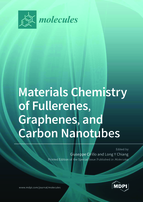Materials Chemistry of Fullerenes, Graphenes and Carbon Nanotubes
A special issue of Molecules (ISSN 1420-3049). This special issue belongs to the section "Materials Chemistry".
Deadline for manuscript submissions: closed (28 February 2022) | Viewed by 36542
Special Issue Editors
Interests: nonlinear photonic C60-chromophore nanoconjugates; core-shell C60-DPAF nanomaterials as photoswitching dielectrics; targeting C70-meso-chlorin as aPDI nanomedicine
Special Issues, Collections and Topics in MDPI journals
Interests: nanomaterials; biomaterials; carbon nanostructures; composite and hybrid materials; biomedical applications of functional materials; therapeutic devices; surface chemistry
Special Issues, Collections and Topics in MDPI journals
Special Issue Information
Dear Colleagues,
Nanocarbon compounds, including but not limited to fullerenes, graphenes, and carbon nanotubes, are attracting increasing interest due to their superior physic chemical, mechanical, and biological features. Such materials have been proposed for several applications in different research fields, from chemistry and engineering to electronics, materials science, energy management, and biomedicine.
This Special Issue is intended as a platform for interactive material science articles (either research and review articles) with an emphasis on the functionalization chemistry, preparation, and characterization of nanocarbon compounds, as well as all aspects of physical properties of functionalized, conjugated, or hybrid nanocarbon materials, and their associated applications. The ultimate aim is to collect all the recent advances in the field, highlighting the strengths and the weaknesses of each nanostructure and providing new ideas for researchers working in this multidisciplinary area.
Prof. Long Y Chiang
Prof. Giuseppe Cirillo
Guest Editors
Manuscript Submission Information
Manuscripts should be submitted online at www.mdpi.com by registering and logging in to this website. Once you are registered, click here to go to the submission form. Manuscripts can be submitted until the deadline. All submissions that pass pre-check are peer-reviewed. Accepted papers will be published continuously in the journal (as soon as accepted) and will be listed together on the special issue website. Research articles, review articles as well as short communications are invited. For planned papers, a title and short abstract (about 100 words) can be sent to the Editorial Office for announcement on this website.
Submitted manuscripts should not have been published previously, nor be under consideration for publication elsewhere (except conference proceedings papers). All manuscripts are thoroughly refereed through a single-blind peer-review process. A guide for authors and other relevant information for submission of manuscripts is available on the Instructions for Authors page. Molecules is an international peer-reviewed open access semimonthly journal published by MDPI.
Please visit the Instructions for Authors page before submitting a manuscript. The Article Processing Charge (APC) for publication in this open access journal is 2700 CHF (Swiss Francs). Submitted papers should be well formatted and use good English. Authors may use MDPI's English editing service prior to publication or during author revisions.
Keywords
- Nanocarbon compounds;
- Carbon nanohybrids;
- Chemical functionalization;
- Characterization routes.








